31 Traditional French Foods To Try in 2025
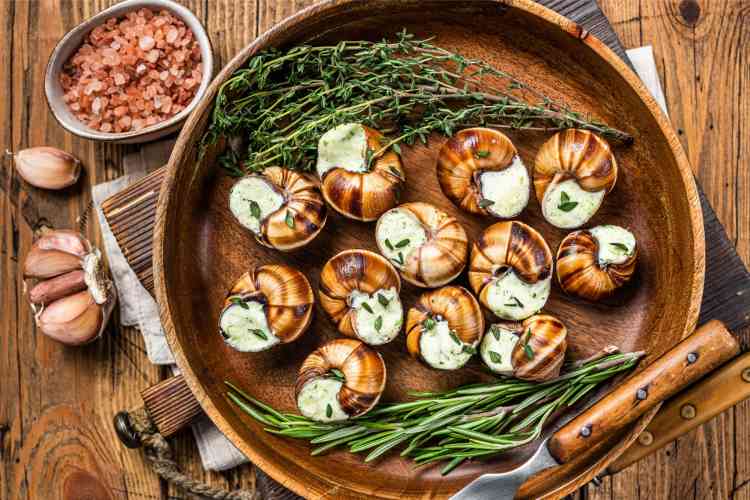
French food is perhaps the thing that draws more people than ever to this iconic European country. Shaped by centuries of meticulous culinary innovation and now deeply rooted in tradition, there are no countries on the planet more strongly associated with the culinary arts.
For curious culinary enthusiasts, this makes a trip to France something of a bucket-list adventure. But it also raises a key question, particularly for those with only limited time to make the most of it: which traditional French foods are most worth trying?
Don’t worry, we’re here to help. From popular French foods that you’ll know from your nearest bistro to traditional French foods that absolutely have to be tried in their home country, if you’re an epicurean planning your next adventure, this guide has you covered.
Jump to Section
How We Choose These Popular French Foods
In a bid to find the best French foods to try, we relied on two things: our own experience and reviews from like-minded foodies. We work with countless chefs around the world (including many French chefs), each drawing on years of experience in the industry. That means that we have decades of combined culinary expertise to draw from.
As for reviews, we scoured the internet to find popular French foods that epicurean adventurers recommend most. These include everything from local specialties rooted in gourmet traditions to the best French foods to try at your nearest bistro.
We even consult historical and cultural sources to highlight dishes with a rich history in the country. This all combines to create an ultimate guide to the French dishes you can’t miss trying.
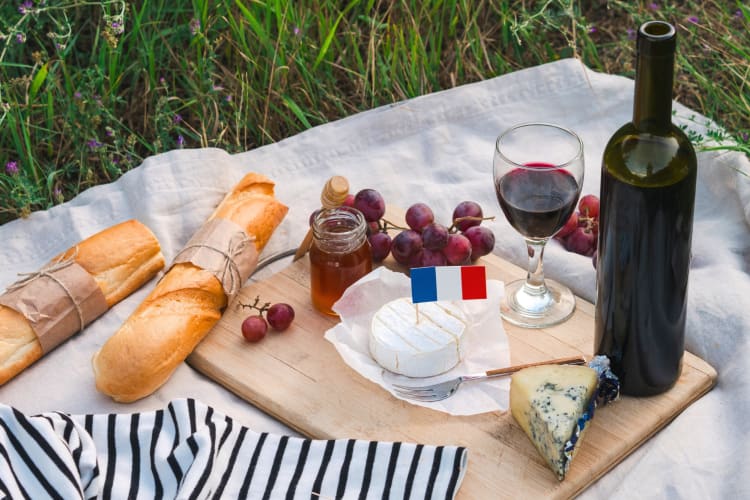
31 Iconic French Foods To Try
1. Escargots
What are escargots, you ask? Well, let us ask you this: what’s the first food that you think of when the topic of French food comes up? Is it snails? If so, then you already know what escargots are!
Usually doused in a hearty dose of butter, garlic and fresh herbs, while snacking on garden variety snails may not seem like your idea of a good gourmet time, you might just be surprised at how good this French food tastes.
Some believe the dish was first popularized by Julius Caesar over 2,000 years ago. However, there is evidence to suggest that it’s been around for much longer. Either way, this French food can be found on restaurant menus around the country and is especially popular as a starter on special occasions.
- Pairs With: An acidic white wine, like sauvignon blanc, which helps to cut through the escargots’ richness.
- Suitable For: Meat eaters
- Cooking Notes: Butter, garlic, parsley and shallots are all you need to prepare authentic escargots.
- Where to Buy: Restaurants around France and some French restaurants in other countries.
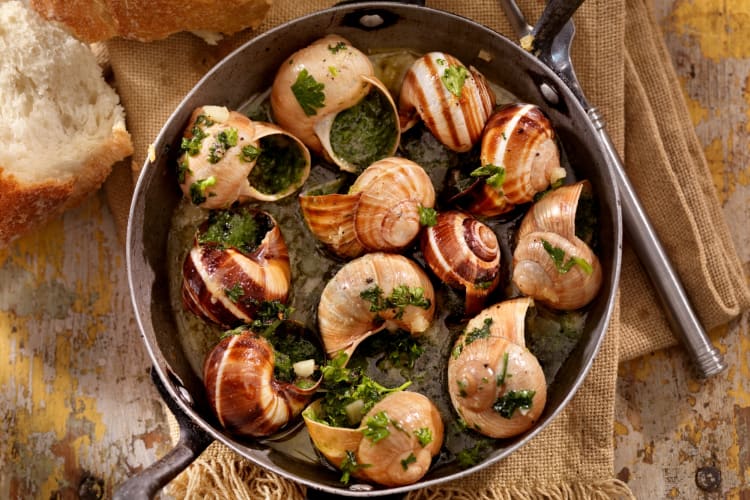
2. Boeuf Bourguignon
We challenge any carnivore to turn down tender chunks of beef simmered in a rich red wine and vegetable stew. This is the epitome of comforting French cuisine and another of the most iconic French foods on this list.
The warming cold weather recipe has been a staple since the Middle Ages, particularly in Burgundy, where beef and red wine are staple ingredients. It’s the sort of French food that makes you look forward to winter — packed with nourishing vegetables, oozing with fruity red wine flavors and slapping your palate with savory flavors of bacon and mushrooms.
- Pairs With: Most red wines.
- Suitable For: Meat eaters
- Cooking Notes: The ingredients list is fairly extensive. This French food can also take a few hours to prepare, but the tender beef and flavor-packed stew are worth the effort.
- Where to Buy: Restaurants around the country, especially in Burgundy, and French restaurants around the world.
3. Croissants
Arguably the most ubiquitous French food on the planet, croissants have become a breakfast staple around the world. But did you know that they actually originated in Austria?
It was only in the 1800s that Austrian baker August Zang opened a Parisian bakery and began serving kipferls — a type of Viennese pastry made with brioche dough. By the early 20th century, laminated dough replaced the brioche, and thus the poster boy of French pastry was born.
Best enjoyed in the morning — preferably with a coffee — this French food is known for its buttery flakiness and gentle sweetness. You’ll find them in bakeries across the country, both plain and with an array of delicious fillings.
- Pairs With: Coffee (or hot chocolate if you have a major sweet tooth).
- Suitable For: Vegetarian, although vegan croissants can be made.
- Cooking Notes: While the ingredients list for this French food is fairly simple, the pastry lamination process requires careful attention. Find a simple recipe and stick to it!
- Where to Buy: Bakeries across France, as well as global bakeries and grocery stores (although quality and authenticity will vary).

4. Soufflé
Meaning “to blow” or “to puff up,” this literally-named and impossibly fluffy French food is the white whale of home cooks around the world. In its simplest form, it’s a baked-egg dish that can be both sweet and savory, flavored with everything from chocolate to cheese.
In terms of its origins, it is first attributed to Vincent La Chapelle in the 18th century. However, his recipe was later developed, perfected and popularized by Marie-Antoine Carême, before becoming symbolic of the most refined French cuisine.
- Pairs With: Savory soufflés pair well with full-bodied chardonnay. For sweet versions, consider sweet botrytized wines like Sauternes.
- Suitable For: Vegetarians
- Cooking Notes: Precision is key to making a soufflé. This includes properly whipping your egg whites, gently folding them into the base mix, and maintaining a precise oven temperature.
- Where to Buy: If you happen to be in Paris, then the obvious place to try this French food is at a dedicated soufflé restaurant. If you’re not, there’s a good chance your nearest French bistro has a soufflé on the menu.
5. Crème Brûlée
This French food is the stuff of many a sweet-toothed dream. Think dreamy custard beneath a perfectly caramelized sugar top.
The recipe for crème brûlée was first published in the 1600s by French chef François Massialot, a cook in the Palace of Versailles. It’s suggested that he was inspired by the Spanish crema Catalana.
Today, this French food is revered by gourmands for the crackly, bittersweet sugar cap and the satin-like custard that awaits beneath. If you’ve never tried it before, trust us: you’ll never forget your first crème brûlée!
- Pairs With: Sauternes, a French dessert wine from the Bordeaux region.
- Suitable For: Vegetarians, but can be made vegan with vegan custard.
- Cooking Notes: Ensure you strain your custard for the smoothest final results. Vanilla pods are preferable, but vanilla extract will also work.
- Where to Buy: This French food is a classic that you’ll find on restaurant menus around the country and across the world.
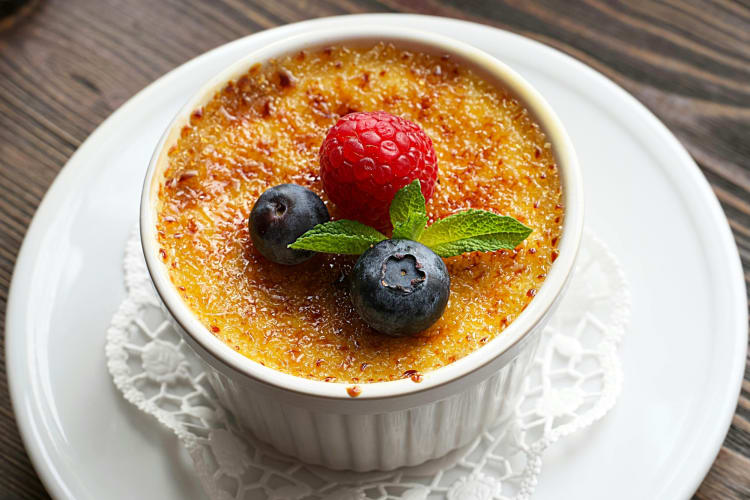
6. Gratin Dauphinois
How do thinly sliced potatoes cooked to tender perfection in garlic-laced cream sound? Good, right? Well, that’s pretty much exactly what to expect from this delicious French food. It’s been a staple in France since the late 1700s, originating in the Dauphiné region.
The essentials to make it are really quite simple — potatoes, milk, cream, butter and garlic. But throw in some extras, like Gruyère cheese and even a sprinkling of thyme, and it’s also one of the most versatile French foods on this list. It’s additionally one of the best sides for any number of main courses, but be warned: it’s very rich!
- Pairs With: Any chardonnay wine.
- Suitable For: Vegetarians
- Cooking Notes: Slice the potatoes thinly enough to ensure they cook through.
- Where to Buy: You can buy ready-made versions of this dish, but as with any French food, it’s best when made fresh. Many restaurants across France serve this on their menus, and it can also be found at French restaurants outside of France.
7. Baguette
Long loaves of bread have been part of French food culture for centuries. However, the modern form of the French baguette is only believed to have originated in the 18th and 19th centuries.
Some hold that a restriction on baking hours in the 1920s made it difficult to bake traditional round loaves in time for breakfast and was therefore responsible for the baguette we know today.
Whatever the reason for their wand-like evolution (“baguette” translates as “wand”), they’re now an integral part of the French food scene. And they can be eaten in a multitude of ways.
Enjoy a simple slice with butter or place a piece at the heart of a classic bouillabaisse. Our personal favorite way to enjoy this French food is to tear it into chunks and dunk it into a freshly baked wheel of Camembert.
- Pairs With: It’s great by itself, but also pairs well with any number of French foods.
- Suitable For: Vegetarians and vegans.
- Cooking Notes: The key to making authentic French baguettes is creating steam in your oven during the initial baking phase.
- Where to Buy: Boulangeries across France are sure to have baguettes, provided you arrive early enough!

8. Coq au Vin
One of the most timeless French foods, trying this chicken casserole in France is toward the top of most people’s foodie bucket list. As for its history, some believe that it dates back thousands of years. However, records of recipes only appear from the 20th century onward, so the jury remains out on precisely when it was first concocted.
Today, the dish is loved for the succulent chicken and tender vegetables that swim in a hearty red wine sauce. It’s full of complex flavors, which is unsurprising given the long list of ingredients that are required to make it.
- Pairs With: A medium-bodied red wine with good acidity, like pinot noir.
- Suitable For: This French food is perfect for meat-eaters seeking an iconic taste of France.
- Cooking Notes: Ensure the chicken is properly braised in order to ensure it remains juicy and succulent.
- Where to Buy: Restaurants across France and French restaurants in other countries.
9. Crêpes
This French food holds a special place in the hearts of sweet-toothed epicureans around the world. It’s also a fantastic choice to pair with an array of savory fillings, making it one of the most versatile dishes to call France home.
Its origin story? Apparently, crêpes were accidentally created in Brittany in the 1200s, when a local woman accidentally spilled buckwheat porridge on a hot stove. However, many say this is just folklore, with the true origin of crêpes not 100% known.
You’ll likely have enjoyed this French food with a chocolate filling, most likely Nutella, but it also pairs well with simple adornments like lemon and sugar (which are arguably the most classic toppings in France).
Prefer something savory? Chicken, mushrooms, cheese and asparagus are all winning options. In the U.S., you may even enjoy the likes of blueberry crêpes for breakfast, but these types of recipes are not the most authentic ones to try, despite being delicious.
- Pairs With: Coffee
- Suitable For: Vegetarians and meat eaters, depending on toppings and fillings.
- Cooking Notes: The batter can be made with or without vanilla, depending on whether you prefer sweet or savory. If making at home, ensure you get the crêpe as thin as possible when cooking, using much less batter than you would for an American pancake recipe.
- Where to Buy: You’ll find crêperies around France serving this iconic French food. It can also be purchased from street vendors and at some cafés. You may find crêperies and restaurants serving crêpes in your local area as well.
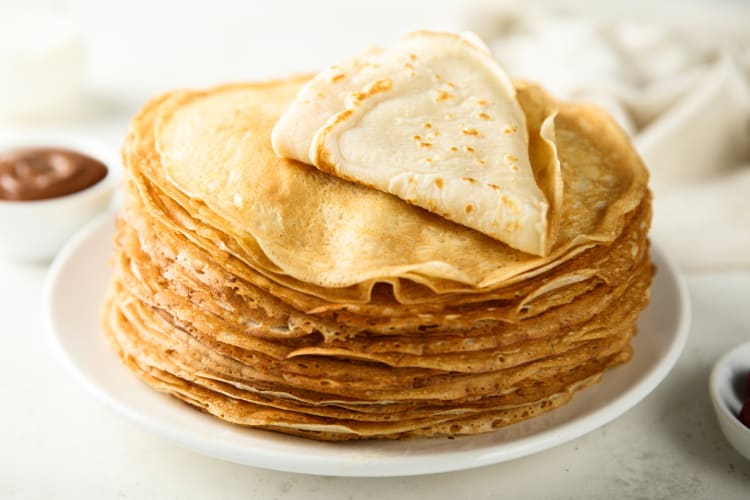
10. Salade Niçoise
Originating in Nice and described by a previous city mayor as “a product of the sun,” it’s hard to overstate just how reminiscent of summer this French food is. It hails from the 19th century, when locals made the most of the exciting produce coming into the city’s busy port.
What the original included, it’s hard to say. Like other French foods, this one has evolved enormously over the years.
Today, you can typically expect a salade niçoise to include boiled eggs, tuna, potatoes, tomatoes, lettuce, green beans, olives and a tangy-tart vinaigrette. It’s crisp, tart, sweet and oily all at once. Oh, and it’s absolutely delicious.
- Pairs With: Given the dish’s brininess, a dry rosé is a great choice to help cleanse the palate.
- Suitable For: Pescatarians (can be made vegetarian by omitting tuna from the recipe).
- Cooking Notes: Given the debate around which ingredients do and don’t belong in this French food, feel free to get creative with your own recipe.
- Where to Buy: Restaurants around France, especially in Nice, where the dish originates, and French restaurants around the world.
11. Ratatouille
Up next is perhaps the most iconic French food for vegetarians and vegans (assuming no butter is used for sautéing). The dish is made with fresh vegetables, which are simmered in a summery, tomato-based sauce. As for its origins, the debate is split between two likely stories.
Most agree that it originated in Provence in the 18th century. However, while some believe it was inspired by similar dishes in neighboring Spain, others hold that it was a dish concocted to help farmers use up overripe vegetables.
Either way, what most agree upon is that it’s one of the tastiest meat-free French foods. If you’re planning a trip to France and happen to find it on the menu of a local restaurant, we urge you: try it!
- Pairs With: A fruity rosé wine from Provence complements the earthiness of the vegetables.
- Suitable For: Vegetarians and vegans.
- Cooking Notes: While the dish isn’t difficult to make, prep is key, including chopping the vegetables into uniform sizes.
- Where to Buy: Restaurants in this French food’s home region, Provence, have to be the best place to try it. But it can be found at other restaurants across the country and in global French restaurants.
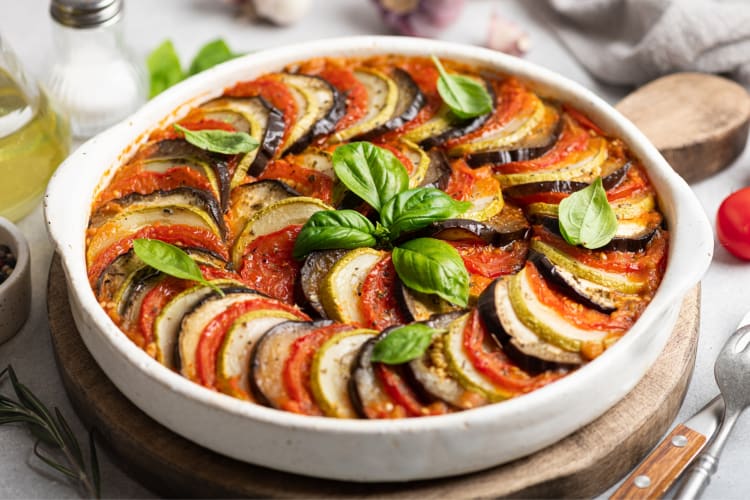
12. Gruyère
Delicious as it is and only improving in flavor when cooked, Gruyère pairs well with plenty of other French foods on this list. It could be on top of gratin dauphinois, mixed into quiche Lorraine or simply by itself.
In terms of its origins, it comes from Gruyères in Fribourg, Switzerland, but quickly made its way onto the French food scene. While it soared in popularity during the Medieval period, it’s likely that the cheese had been in production by local artisans for centuries before.
As for the taste, it depends on the cheese’s age. Younger versions are milky and supple. With age, the flavor begins to deepen with hints of caramel, spice and nuttiness, plus a gradually firmer texture.
- Pairs With: It pairs well with both red and white wines. Oak-aged chardonnay can help enhance the cheese’s nutty notes.
- Suitable For: Vegetarians
- Cooking Notes: Grate it on top of gratin dauphinoise and grill for a deep, nutty finish.
- Where to Buy: Fromageries around the country and cheese shops and grocery stores across the globe.
13. Bouillabaisse
This traditional French seafood stew hails from Marseille in the Provence region. In the 19th century, sailors would keep the less desirable part of their catch for themselves, selling the rest at market.
In a bid to keep things interesting at the dinner table, they would pair the fish with a flavor-packed concoction of braised vegetables, and so the dish of bouillabaisse was born.
Today, while the fish and shellfish certainly characterize its flavor profile, this iconic dish is often underpinned with notes of saffron, fennel and orange zest. It’s typically enjoyed over two courses. The first is poured over crusty bread with a spicy garlic mayonnaise known as “rouille.” This is then followed by the fish and shellfish, which are served on a separate platter.
- Pairs With: Sauvignon blanc wine complements the salty flavors of this French food.
- Suitable For: Pescatarians
- Cooking Notes: Adjust the ingredients list to feature your favorite fish and shellfish.
- Where to Buy: Find a waterfront restaurant in Marseilles, and there’s a good chance this French food will be on the menu.

14. Profiteroles
Profiteroles are a regular fixture in the refrigerated section of grocery stores the world over, often piled into tempting choux pastry pyramids and daring you to resist adding them to your basket. Filled with either custard or cream and usually finished with a drizzle of chocolate for good measure, this is a must-try dessert for anybody hoping to sample the best French food.
Now, there is some evidence to suggest that this dessert has Italian roots. However, they have since become one of the most renowned dishes on the French culinary scene, firmly earning a title as one of the best French foods.
- Pairs With: A lightly fortified wine like vin doux naturel is usually a safe bet for such a sweet dessert pairing.
- Suitable For: Vegetarians
- Cooking Notes: Follow the choux pastry recipe instructions to the tee.
- Where to Buy: This French food is a staple in bakeries across France. It may also be seen on dessert menus and can be purchased at some international grocery stores.
15. Soupe à L'oignon
Featuring beef broth, onions, garlic, white wine and thyme, plus a crusty island of bread topped with melted (almost crispy) Gruyère, this has to be one of the most comforting French foods on this list.
Described by some as a “liquid sandwich,” it’s the ultimate winter warmer. Fortunately, if you happen to be visiting France during the colder months, you’ll find this French food served at restaurants across the country.
- Pairs With: An acidic wine cuts through the richness of this dish perfectly. Our recommendation would be a sauvignon blanc.
- Suitable For: Meat eaters, due to the beef broth. It could be made vegetarian with a vegetable-based broth.
- Cooking Notes: Grill the Gruyère until the cheese begins to brown for best results.
- Where to Buy: Sample this dish during the winter months at restaurants across the country.
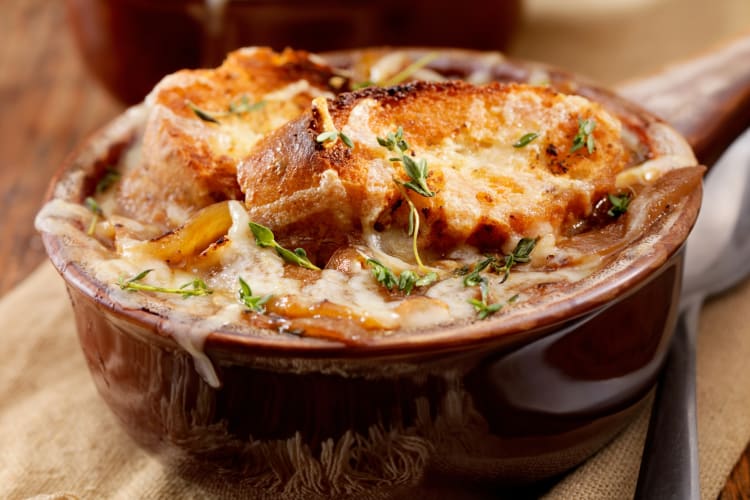
16. Foie Gras
This French food is one of the simplest on this list, and is believed to hold origins in ancient Egypt. That’s more than 4,500 years ago! It features duck or goose liver, sugar, salt and pepper, plus the optional addition of white wine or brandy.
The resulting food is both rich and delicate. The texture is firm and spreadable, making it the perfect accompaniment for a piece of toasted brioche. If you’d like to try it, you’ll find it on the menus of restaurants across the country.
But the best place has to be in the south west, particularly in areas like the Dordogne, which are known for their quality foie gras production.
- Pairs With: Sweet wines like Monbazillac pair perfectly with the fatty richness of foie gras
- Suitable For: Meat eaters
- Cooking Notes: Keep the recipe simple to enjoy the naturally rich flavor of the liver
- Where to Buy: Shops, butcher shops and restaurants around the country stock this French food. Look for products made in France’s south-west regions like the Dordogne. High-end restaurants and grocery stores worldwide may also have foie gras for purchase.
17. Macaron
An icon of Parisian treat, this French food has made for itself a permanent place among fancy foodies around the world. Coming in an array of appetizing colors and mouth-watering flavors, it is, in its simplest form, a cookie sandwich.
It’s believed to hold Italian origins, being a staple in monasteries across Venice for centuries. They made their way into French food culture in the 15th century, where they were, until the mid-18th century, reserved for the tables of royalty.
Today, you’ll find them in bakeries across the country. They’re especially prevalent in Paris, where bakery windows across the city almost always have a colorful display in honor of this iconic French food.
- Pairs With: Tea and coffee.
- Suitable For: Vegetarian and gluten-free. Recipes can be found for vegan macarons.
- Cooking Notes: As with most French pâtisserie, precision is key, from accurately measuring ingredients to ensuring the perfect batter consistency and bake. It's also important to leave the piped macarons to rest (for 20 minutes to one hour) in order to form a skin before placing them in the oven.
- Where to Buy: Bakeries across the country sell these iconic French foods. They can also be found in bakeries and even supermarkets in other parts of the world.
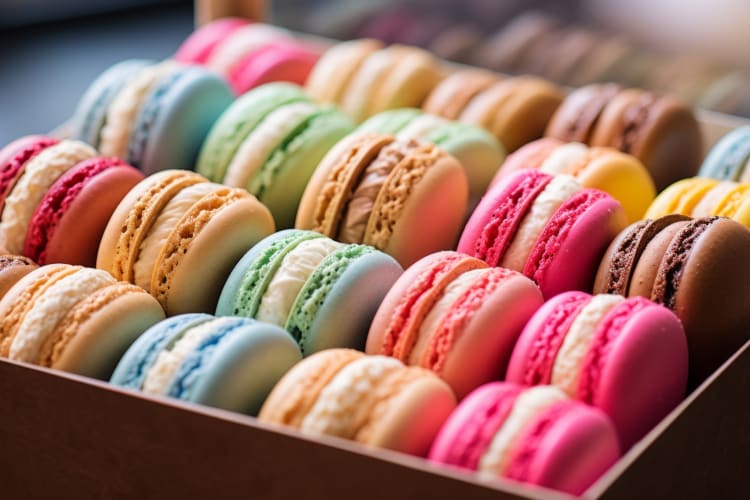
18. Confit de Canard
Anybody who understands French culinary terms will know what this French food is. “Confit” refers to a method of slow-cooking and storing food in fat. “Canard,” meanwhile, is the French word for “duck.”
Back in the 15th century, in the southwestern region of Gascony, the “confit” method of storage was essential for preserving meat and game, preventing the growth of bacteria.
Of course, there’s more to this dish than fatty duck. In fact, typical ingredients that accompany the bird include herbs like thyme, sage, rosemary and oregano, plus shallots, garlic, salt and even juniper berries. The result is fork-tender duck (beneath an impossibly crispy layer of skin), and a gamy, slightly spicy flavor with just a hint of sweetness.
- Pairs With: It has to be a red wine, specifically cabernet sauvignon, whose robust tannins and complex flavors can stand up to the strong flavors of this French food.
- Suitable For: Meat eaters
- Cooking Notes: The key to this dish is dry-curing the duck, which can be a complex process. If you’re unsure, try it at a restaurant instead.
- Where to Buy: Restaurants across France are likely to serve this French food, and it can be found in higher-end French restaurants across the globe.
19. Croque Monsieur
The culinary traditions of France have a way of elevating everyday foods to new gourmet heights. In the case of this French food, while it is, in essence, a sandwich, the ingredients list goes well beyond your standard bread and filling.
First conceived by Parisian Chef Michel Lunarca as a snack for busy workers, it features crusty slices of bread, stacks of salted ham and melty Gruyère cheese. It also includes béchamel sauce (one of the five French mother sauces) and Dijon mustard, so yes: you’ll have to do more than butter the bread if you intend to make one for yourself!
- Pairs With: If you’re enjoying this French food at leisure, pour yourself a glass of dry white like Chablis, whose acidity works wonders with the richness of the sandwich.
- Suitable For: Meat eaters
- Cooking Notes: The recipe is more involved than a regular sandwich and includes the creation of a béchamel sauce.
- Where to Buy: Cafés, restaurants and bakeries around the country.
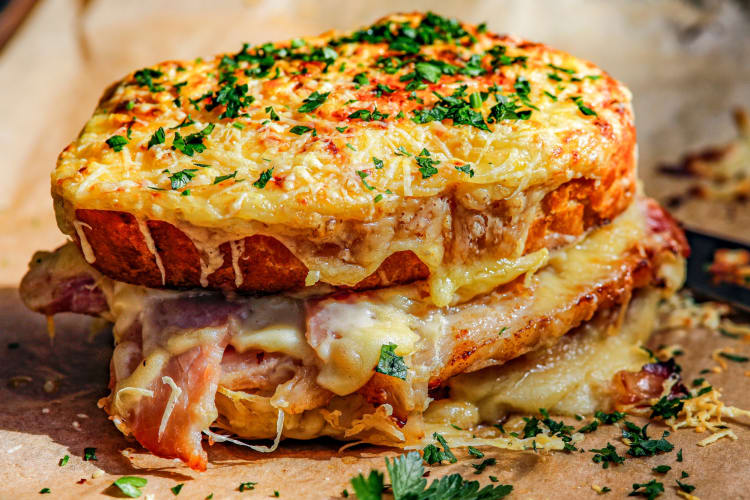
20. Cassoulet
This meaty stew is like the warm hug you didn’t know you needed when visiting France in the winter months. It comprises white beans and proteins that often include pork, sausage, duck and even mutton. Tying them all together? A savory, herbaceous sauce.
Once a peasant dish used to cook up whatever ingredients were in abundance, it’s now popular around the world among even the most refined epicureans. And given its origins, it’s unsurprising that cities across its home region of Occitanie have their own signature styles.
- Pairs With: A full-bodied red is the perfect pairing for this rustic dish.
- Suitable For: Meat eaters
- Cooking Notes: Since there are plenty of variations across France, there’s no reason not to get creative and tailor the dish to your own taste.
- Where to Buy: Being a popular French food, you won’t struggle to find this in restaurants around the country.
21. Tarte Tatin
If you have a sweet tooth, you may well already be familiar with this French food. It’s basically an upside-down tart, featuring caramelized fruits (generally apples) beneath a dome of puff pastry.
Tarte Tatin holds its origins in the Loire Valley French wine region, specifically at the Hotel Tain. According to legend, Stéphanie Tatin accidentally began to cook her signature apple pie before adding the pastry. In a panic, she added the pastry to the top of the by-then half-cooked apples, and so a culinary classic was born.
- Pairs With: A sweet dessert wine like Sauternes complements the apple flavors of this dish perfectly.
- Suitable For: Vegetarians (can also be made vegan with vegan-friendly pastry).
- Cooking Notes: You can make this show-stopping French food with ease by using pre-made pastry.
- Where to Buy: Given its popularity, this French food can be found on dessert menus around the nation.
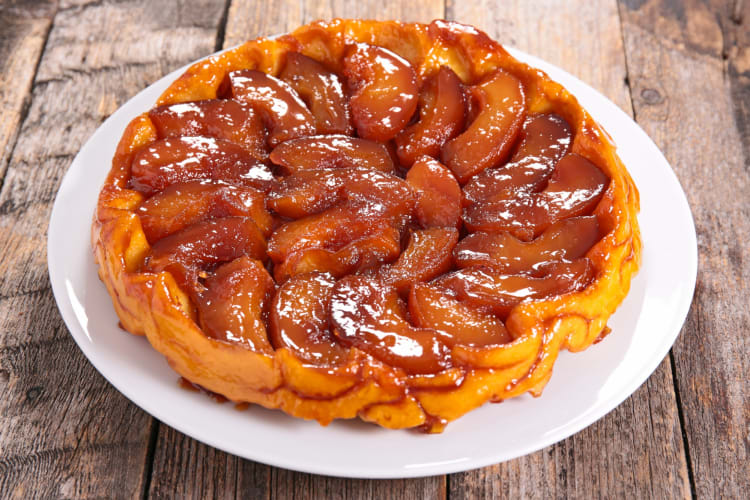
22. Lyonnaise Salad
Originating in the city of Lyon, this staple of Lyonnaise cuisine comprises frisée lettuce, lardons, croutons and a poached egg. These are all tossed in a warm vinaigrette, which is traditionally made with rendered bacon fat and a touch of vinegar, adding a savory tang to the dish that, honestly, is hard to resist.
Sure, the lardons and bacon-laced vinaigrette mean that it’s not exactly the healthy meal that you’d usually associate with the word “salad.” But this Lyon food is a heck of a treat, one that you won’t struggle to find on the menus of restaurants across Lyon.
- Pairs With: A big and bold wine like cabernet sauvignon is needed in order to stand up to the savory bacon flavors.
- Suitable For: Meat eaters
- Cooking Notes: The rendered bacon fat in the dressing is key to achieving the dish’s signature flavor.
- Where to Buy: Restaurants across the Lyonnaise region are likely to offer this regional French food.
23. Mille-Feuille
Another French food for anyone with a sweet tooth, this popular dessert comprises layers of flaky puff pastry and rich vanilla pastry cream. The name translates to “thousand leaves” — a nod to the many layers of puff pastry required to make it.
As for its origins, it’s thought to be the creation of Dijon Chef François Pierre de la Varenne, who published his now world-renowned recipe in 1651. However, the recipe has been altered somewhat since the 17th century.
If you have a penchant for pâtisserie, you’ll find mille-feuille available at bakeries around the world. Of course, there’s nowhere better to try it than in its home country. And if you happen to be in Paris, you won’t need to look far to find one.
- Pairs With: A sweet wine like Sauternes stands up fiercely to the inherent sweetness of this dessert.
- Suitable For: Vegetarians. Vegan versions may be available.
- Cooking Notes: Consider buying pre-made puff pastry to save time and make your life easier!
- Where to Buy: Bakeries around the world, especially in Paris.
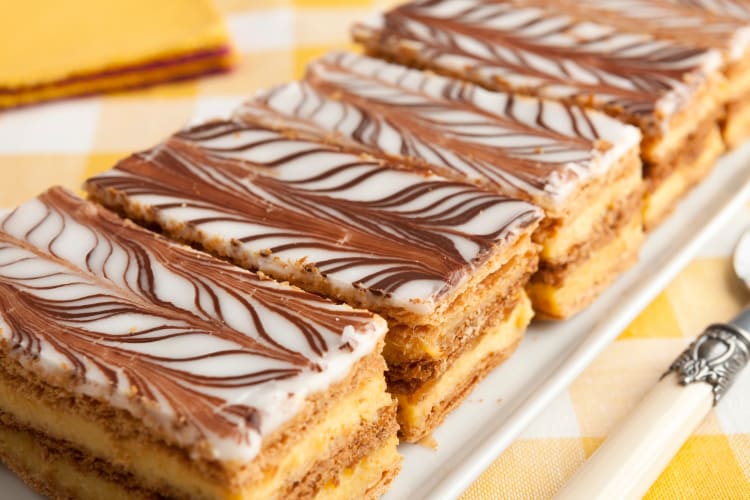
24. Lobster Thermidor
This French food classic features tender lobster cooked in a rich wine sauce, often with the inclusion of Cognac, before being returned to the shell for optimum presentation. Before serving, it’s topped with a layer of Gruyère cheese and broiled.
The origins of this French food are unclear. Some hold that renowned French general Napoleon Bonaparte had something to do with it — that he ate the dish in the French Republican Calendar Month named “Thermidor.”
Others believe the dish was eaten — and named — in honor of a Parisian play named “Thermidor,” which debuted decades after Napoleon’s death. However it first came about, it remains one of the most decadent French foods you’re likely to find on any menu, anywhere.
- Pairs With: This decadent seafood dish deserves no less than the best vintage Champagne, one with the acidity to cut through the creamy richness of the sauce.
- Suitable For: Pescatarians
- Cooking Notes: While the dish isn’t especially tricky to make, it requires precision when removing the meat and returning it to the shell.
- Where to Buy: While not commonly available, it is possible to try this dish at renowned Parisian restaurants like Bistrot Paul Chêne and Le Thermidor.
25. Camembert
This French food was born out of France’s rich cheese-making traditions and is named, quite simply, for the Normandie town in which it was born.
Tangy, earthy and slightly sweet would all be solid descriptors for this globally popular French food. As for how to enjoy it, it’s hard to beat a whole baked wheel of Camembert. It’s the ultimate “dip” for crusty pieces of French baguette.
- Pairs With: Crusty French bread and a glass of chenin blanc.
- Suitable For: Vegetarians
- Cooking Notes: Pierce the top of the camembert before baking to help steam escape and ensure an even melt.
- Where to Buy: You’ll find camembert being sold in fromageries across France as well as in grocery stores and cheese shops in other countries.
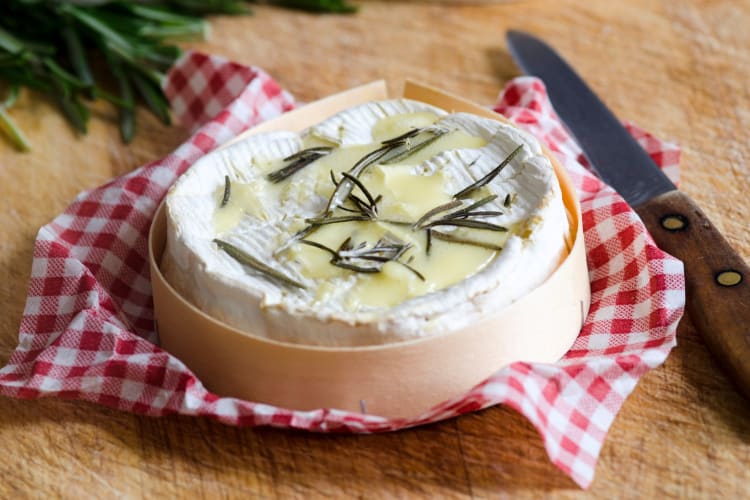
26. Pot-au-Feu
As one of the oldest French foods — and widely regarded as the country’s national dish — pot-au-feu is a must-try if you have the chance. Translating as “pot on fire,” it was originally cooked over an open fire as a means of tenderizing cheaper cuts of meat and whatever vegetables were available.
While you’ll find differing variations of this French food depending on where you are in the country, you’ll notice that it’s almost always eaten the same way. Similarly to bouillabaisse, the broth is served first, followed by the meat and vegetables.
- Pairs With: The full-bodied flavors of the dish need a wine to match. This makes a robust Burgundy a solid pairing.
- Suitable For: Meat eaters
- Cooking Notes: For an authentic take on this French food, cooking cheaper cuts of meat for a long time at a low temperature is key to achieving tender perfection.
- Where to Buy: Traditional bistros in France are likely to have this popular French food on the menu.
27. Vichyssoise
This velvety soup is best served cold, but don’t think for a second that it’s not comforting. It pairs cooked and puréed leeks, starchy potatoes, onions and cream and is usually served during the warmer months as a first course. Based on a traditional potato and leek soup, this chilled version was first conceptualized by Chef Louis Diat.
What we love about this particular French food is its versatility. You can play around with the base ingredients and choose not to purée certain elements; you can use stock instead of plain water; you can also garnish it with your favorite French cheeses. Our favorite adornment, however, is crunchy garlic croutons. Try it for yourself and thank us later!
- Pairs With: An acidic chardonnay can help cut through this French food’s inherent richness.
- Suitable For: Vegetarians
- Cooking Notes: Get creative with your toppings. If you prefer a chunky soup, you can forgo puréeing the leeks.
- Where to Buy: This classic French food is available at brasseries, bistros and upscale restaurants around the country.
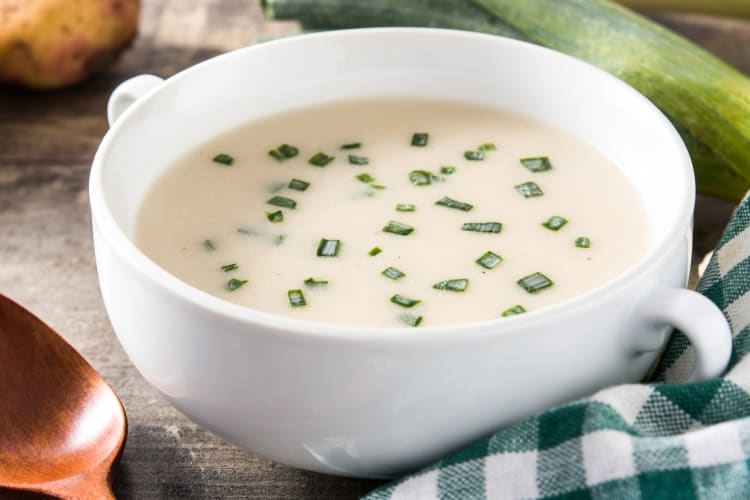
28. Quiche Lorraine
Up next is a dish that’s so popular around the world that some might not even know it’s a French food. But it actually has a long history in France, one that dates all the way back to the 14th century.
In fact, it has roots in 14th-century Germany, whose sweet cake recipe inspired neighbors in the Grand Est region of France to take the pastry base and top it with an array of savory ingredients.
Today, the dish we know and love features a crusty pastry base and a delicious creamy filling of eggs, cream and cheese. Throw in some bacon, onion and a pinch of nutmeg, and it’s easy to see why this French food has stood the test of time.
- Pairs With: Pinot blanc wine highlights the savoriness of the bacon.
- Suitable For: Meat eaters (can be made vegetarian by removing bacon from the recipe).
- Cooking Notes: Opt for a store-bought crust to make preparation quicker and easier.
- Where to Buy: You’ll find this French food available in bakeries around the country.
29. Rillettes
This French food is actually a type of pâté, traditionally made by slow-cooking pork in its own fat (similarly to confit), before shredding it and combining it with the fat. The result is a spreadable, albeit slightly stringy, paste, perfectly seasoned and best served on toasted bread with gherkins.
Rillettes have a long history in the world of French food; in fact, they’re thought to date all the way back to the Middle Ages. Whatever their origins, they deliver the same delicious simplicity that’s characteristic of so many other fantastic French foods.
- Pairs With: A Loire Valley chenin blanc has the perfect acidity to cut through the rillettes’ fatty richness.
- Suitable For: Meat eaters
- Cooking Notes: A slow-cooking process is key to ensure the pork is tender enough to shred.
- Where to Buy: Restaurants and grocery stores around France will sell this specialty item.
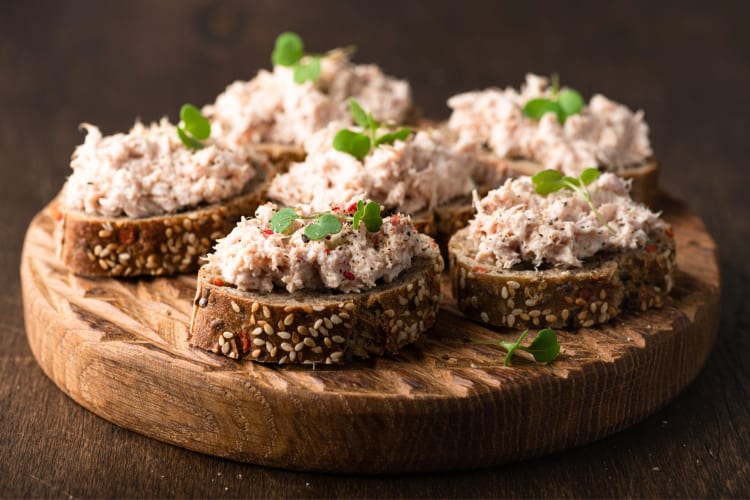
30. Chicken Chasseur
This next French food is something of a bistro classic, often paired with mashed potatoes or, you guessed it, a crusty slice of baguette. The name translates as “hunter’s chicken" and is said to derive from the fact that it was served to French hunters upon their return from the forest.
Whether or not that’s true, it really doesn’t matter. Typically featuring chicken, mushrooms, shallots, tomatoes and white wine, don’t let the simplicity of the ingredients list fool you. It tastes every bit as comforting and luxurious as you’d expect from one of the most quintessentially French foods.
- Pairs With: A neutral white wine like pinot grigio complements the flavors of this French food without overpowering them.
- Suitable For: Meat eaters
- Cooking Notes: Quality ingredients are key to getting the most out of this simple but hearty recipe.
- Where to Buy: Look for restaurants specializing in traditional French food.
31. Paris-Brest
What better way to end our guide to French foods than on a sweet note? The Paris-Brest features choux pastry, which is filled with praline cream. Hidden beneath the cream is a crunchy, buttery and oh-so-indulgent praline concoction, and the whole ensemble is finished with slices of almonds and icing sugar.
If you’re a cycling enthusiast who’s never tried one of these before, the name will probably ring a bell. That’s because this Paris food was named after a cycling race of the same name, and this deliberately wheel-shaped sweet treat is very much a favorite in the hearts of both French foodies and cycling fans.
- Pairs With: A botrytized wine like Sauternes is the perfect partner for this sweet French dessert.
- Suitable For: Vegetarians
- Cooking Notes: Precision is key here, both for the choux pastry and the creation of the praline cream. Follow your recipe with care!
- Where to Buy: Bakeries around Paris are likely spots to find this French food.
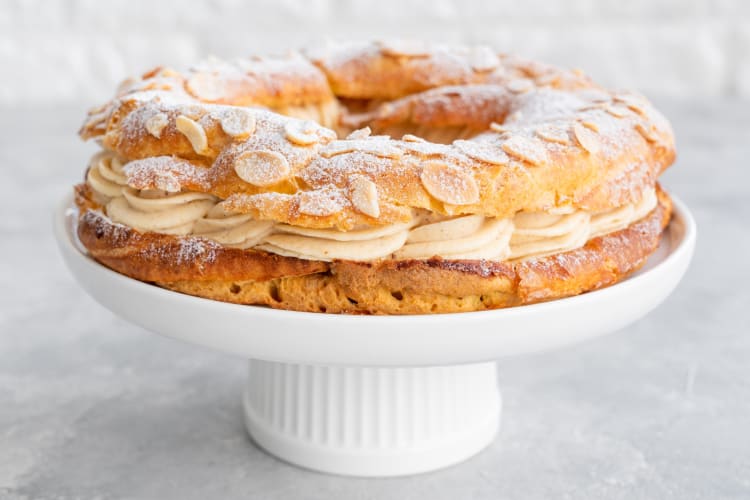
Learn To Cook French Food
If you’re hoping to master your favorite French recipes, why not consider signing up for cooking classes near you? Guided by a renowned local chef, you’ll quickly find yourself getting to grips with authentic ingredients and the time-honored techniques required to recreate your French brasserie favorites.
Even if you can’t make an in-person session, there are plenty of online cooking classes available for you to choose from. These are especially handy if you have friends around the world with whom you share a love of food. You’ll benefit from the same expert guidance as in-person classes, but you can enjoy the experience together regardless of whether or not you’re in the same timezone!
Perhaps you’re planning a trip to France. If so, there’s nowhere better to learn to cook French dishes than in their mother country! From cooking classes in Paris to cooking classes in Lyon, if you’re embarking on an epicurean adventure and hoping to add an authentic French string to your culinary bow, there’s no better way to do it than with the guidance of a renowned French chef.
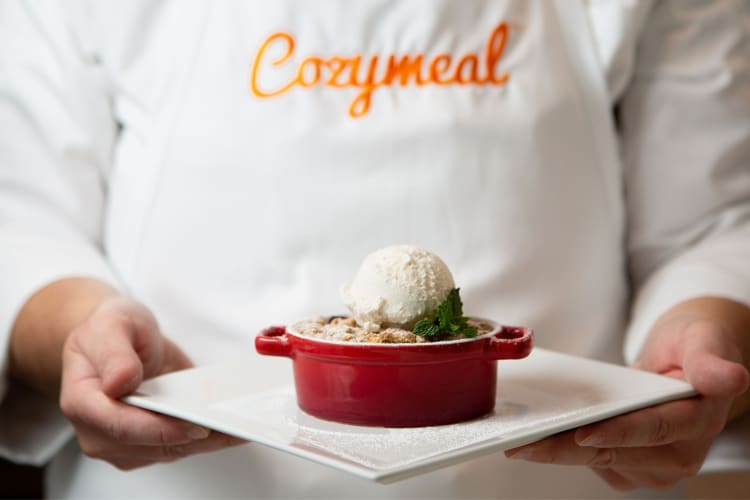
From delicate starters like escargots and onion soup to hearty mains like coq au vin and cassoulet, there’s a lot to sink your teeth into in this guide to French food. And that’s before you even think about sampling some of the country’s famous desserts like tarte tatin and crème brûlée!
While it’s nearly impossible to experience every dish in one trip to France, there’s a good chance that your local bistro has a few of the above items on the menu. And even if it doesn’t, so what? Nobody said you can’t book another trip to Paris…
For even more ways to explore your favorite foods, check out other experiences happening on Cozymeal.



FOOD FOR THOUGHT?
Join the conversation.